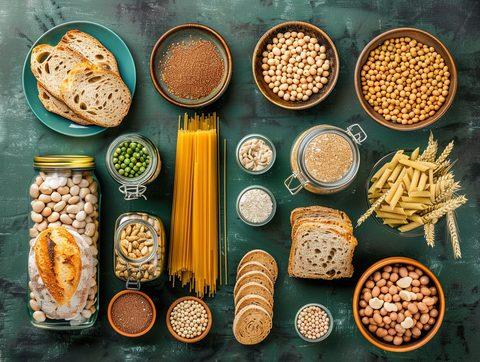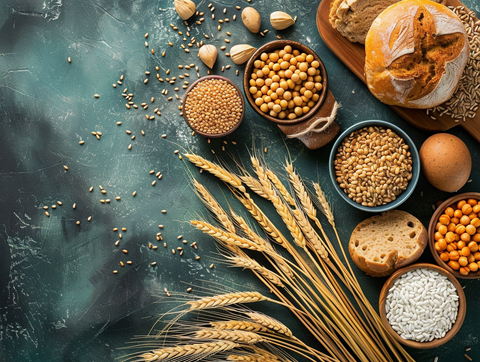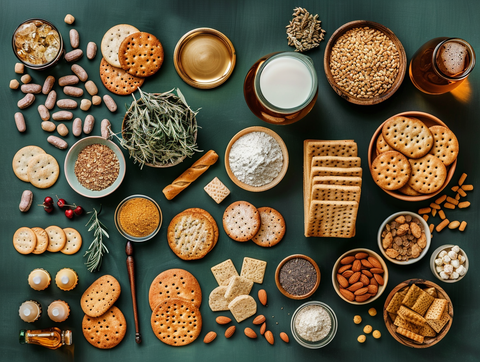Start your journey here
Make positive changes to your daily diet and health, find a test thats right for you.
Wheat is found in items using wheat flour or the wheat grain itself such as bread and bread products, pasta, biscuits, crackers, cereal, cakes and pastry products. It is also often used as a thickener so can be found in soups, sauces, stews and processed meals. It can also be found in beer, ale and lager.
Wheat intolerance is caused by your body’s inability to digest or metabolise wheat, which leads to symptoms often experienced around the stomach and gut that range from mild to severe. It’s relatively common, which means there are plenty of wheat-free products available so that you can still eat the food you enjoy but avoid unpleasant or painful symptoms.
While wheat does contain the protein gluten, gluten isn’t specific to wheat. If you have a wheat intolerance, you’ll only experience symptoms after eating wheat. If you have a gluten intolerance, you’ll not only experience symptoms after eating wheat, but all other cereals and grains that contain gluten as well.
For more information read our article on the difference between a wheat intolerance and gluten intolerance.
Coeliac disease is when your body’s immune system attacks healthy cells every time you eat gluten, which can cause damage to the lining of your gut which can lead to problems with digestion. This can have a major impact on your long-term health, unlike with an intolerance, which only causes short-term effects.
A wheat allergy is caused by your body’s immune system incorrectly interpreting wheat as a threat, triggering it to attempt to fight it. This is what causes the symptoms, which are often similar to that of a cold or flu.
A wheat intolerance is caused by the body’s inability to process it. The symptoms can be similar to an allergy, but often centre around the gut or stomach.
Wheat intolerance is fairly common, which is one of the reasons why there are so many alternatives to wheat-containing products on the market.
Many very young children have a wheat sensitivity or allergy due to their developing digestive and immune systems, but the majority will grow out of it as they enter their teens.
Because wheat is a member of the Poaceae family, it’s common for adults with a wheat allergy or intolerance to also have an allergy to other species in the family, including grass pollen. That being said, an intolerance can develop at any stage throughout your life, even if you’ve never experienced symptoms before.
If you have symptoms every time you eat food containing wheat, there’s every chance you do have an intolerance. Here’s our wheat intolerance symptoms checklist so you can see if what you experience lines up, which may arise immediately or several hours later:
If you have a wheat intolerance, there are two major ways it can impact your diet. The first is that it can lead to a series of painful, unpleasant and potentially embarrassing symptoms every time you eat wheat, which makes eating out in restaurants especially tricky.
The second is that it’ll encourage you to take a closer look at product labels to make sure the food you buy doesn’t include wheat. Even though wheat is a common ingredient in many foods, there are plenty of alternatives available so you can continue eating your favourites.
As we’ve already highlighted, there are so many wheat-free alternatives available that you don’t have to go far to find the products you enjoy but in a wheat-free way. Many of these will be found in your local supermarket’s gluten-free aisle as there is a lot of crossover.
Check out this list of wheat-free foods you can pick up so you can make positive but tasty changes to your diet:
Flour
|
Bread
|
Cereals
|
Pasta
|
Wheat is used in a wide range of products, so it’s important to read the label on anything new you might buy. But, there are usually gluten- or wheat-free alternatives so you don’t have to miss out.
Our food sensitivity tests are carried out using bioresonance therapy and is categorised under Complementary and Alternative Medicines (CAMs) which covers a wide range of therapies that fall outside mainstream medicine. Tests and related information provided do not make a medical diagnosis nor is it intended to be a substitute for professional medical advice, diagnosis or treatment.
Always seek the advice of your doctor or other qualified health provider if you have a medical condition or with any questions you may have regarding a medical condition and/or medical symptoms.
Whilst it is possible for the body to develop a sensitivity or intolerance to any food or drink item there are certainly those, which are very common.

Caffeine intolerance can trigger symptoms like insomnia and headaches. Learn more about caffeine and how to cope with a caffeine intolerance.

Whilst it is possible for the body to develop a sensitivity or intolerance to any food or drink item there are certainly those, which are very common.

Eggs are the produce of chickens and ducks. Most commonly it is chicken eggs, which are sold and used in processed products. Eggs can come in many forms, boiled, poached, fried, scrambled and omelette. They are also used in baking, mayonnaise, custard, mousse, margarine, meringue and ice cream. Eggs can be separated into egg white and egg yolk, sometimes only part of the egg is used.

Fish intolerance can trigger symptoms like bloating, stomach cramps and headaches. Learn more about fish intolerance, fish allergies and the differences between them here.

Gluten is the name given to a protein found in all wheat, rye, barley and oat products. It acts like a binder in food, giving it elasticity and a springy feel. It is found in all produce which uses wheat, rye, barley or oats such as bread and bread products, pasta, biscuits, crackers, cereal, muesli, cakes and pastries. It can also be found in beer, ale, lager, soups and processed products.

Do you difficulty digestiving food and drink containing lactose?

Whilst it is possible for the body to develop a sensitivity or intolerance to any food or drink item there are certainly those, which are very common.

Wheat is found in items using wheat flour or the wheat grain itself such as bread and bread products, pasta, biscuits, crackers, cereal, cakes and pastry products. It is also often used as a thickener so can be found in soups, sauces, stews and processed meals. It can also be found in beer, ale and lager.

Yeast is a fungus, which feeds on sugars. It is used in the baking of products like bread. It may also be found in pastries, biscuits, crackers, cereals, stock cubes and alcohol, such as beer and cider.